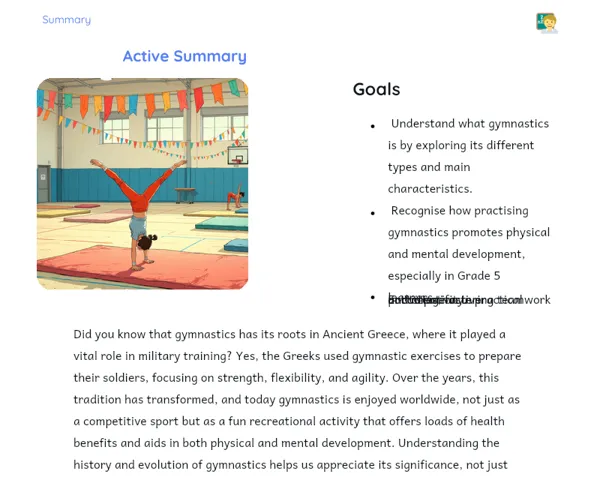Summary Tradisional | Dances: Community and Regional Context
Contextualization
Dances are a vibrant expression of culture found in every community around the globe, including ours here in South Africa. Each region boasts its own unique dances, shaped by local histories, cultures, and traditions. These dances are more than just entertainment; they're vital for preserving and sharing the beliefs and values of a community across generations. In our context, regional dances reflect our diverse cultural tapestry, with different communities celebrating their distinct traditions and rhythms.
In South Africa, some notable regional dances include the Umteyo from the Xhosa people, the Gumboot dance from the mining communities, and the Traditional Zulu dance. The Umteyo, for example, is characterized by its lively hip movements and is often accompanied by singing. The Gumboot dance, born from the struggles of miners, utilizes rhythmic stomping and slapping of boots to create a powerful narrative of resilience. The Traditional Zulu dance features energetic footwork and striking movements that tell stories of history and culture. These dances are crucial for maintaining cultural identity and fostering a sense of belonging and unity among community members.
To Remember!
Cultural Importance of Regional Dances
Regional dances serve as a powerful form of cultural expression that embodies the identity, history, and traditions of a community. These dances are handed down through generations, playing a key role in sustaining local culture. Through dance, communities celebrate their achievements, rituals, and special events, keeping their collective memory alive. They also foster a sense of belonging and strengthen social connections among community members.
Additionally, regional dances carry an educational aspect, teaching younger generations about the values and customs intrinsic to their community. In various regions, schools and community initiatives introduce these dances, ensuring they are appreciated and preserved for the future. Moreover, they have a positive economic impact, attracting tourists and promoting local cultural events and festivals.
It's essential to acknowledge that regional dances differ greatly from one area to another, reflecting the rich cultural diversity unique to South Africa. Each dance showcases its own characteristics, music, attire, and movements that are representative of the community's specific history and culture.
-
Reflect the identity, history, and traditions of a community.
-
Promote a sense of belonging and unity.
-
Play an educational role and have a positive economic impact.
Influence of Music on Dances
Music in our communities directly shapes the movements and styles of dances. Each dance is intertwined with particular music that dictates the rhythm and choreography. For instance, the energetic beat of Gumboot music coaxes lively and syncopated footwork, while the melodic tunes of Traditional Zulu dance promote graceful and intricate movements.
The selection of music is pivotal for maintaining authenticity and emotional expression in dance. Music not only sets the pace for movements but also stirs feelings that are reflected through dance. The unique instruments employed in our regional music significantly contribute to the distinct sound of each dance.
Music and dance are inseparable aspects of our cultural expressions. Together, they provide a complete sensory experience where movement and sound enhance each other remarkably. It's this harmony between music and dance that makes our regional dances so captivating and deeply meaningful.
-
Rhythm and melody determine the steps and choreography.
-
Music defines the rhythm of movements and evokes emotions.
-
Regional instruments contribute to the unique sound.
Examples of Regional Dances in South Africa
South Africa is home to an array of regional dances, each with its own features and cultural significance. The Umteyo, reflecting the vibrancy of the Xhosa people, is celebrated for its lively hip movements and often accompanied by soulful singing. The Gumboot dance, a symbol of our mining heritage, utilizes rhythmic boot stomping and body slapping to convey stories of struggle and triumph.
Traditional Zulu dance, characterized by energetic footwork and intricate formations, showcases the rich cultural tapestry of the Zulu people and is often performed during significant cultural gatherings.
Moreover, these dances are integral to our cultural celebrations and community events, embodying joy and togetherness and highlighting the pride we take in our diverse heritage.
-
Umteyo: lively dance with hip movements and singing.
-
Gumboot: rhythmic stomping dance reflecting mining heritage.
-
Traditional Zulu: energetic footwork representing Zulu culture.
Community Participation
Regional dances often engage the entire community, whether it be through active participation or as spectators. Community festivals and celebrations provide key opportunities for practicing these dances, inviting all community members, regardless of age or skill, to join in. This collective participation fosters social ties and amplifies a sense of connection and identity within the community.
Involving children and youth in regional dances is vital for preserving these traditions. This hands-on engagement allows them to learn about their community's history and cultural values while keeping these practices alive for future generations. Festivals and cultural events are essential for showcasing regional dances, bringing the community together to celebrate traditions, share stories, and express cultural pride. Participation in these gatherings reinforces cultural identity and strengthens the sense of belonging.
-
Involves the whole community, promoting unity.
-
Crucial for the preservation of cultural traditions.
-
Events and festivals are key moments for celebration.
Key Terms
-
Regional dances: Forms of cultural expression that reflect the identity of a community.
-
Community context: Social and cultural environment where dances are practiced.
-
Rhythmic movements: Steps and choreography influenced by the rhythm of the music.
-
Regional music: Typical musical compositions of a region that accompany the dances.
-
Local culture: Set of traditions, customs, and values of a community.
-
Umteyo: Energetic dance from the Xhosa people, known for lively hip movements.
-
Gumboot: Dance with rhythmic movements originating from the mining communities.
-
Traditional Zulu: Dance characterized by energetic footwork and cultural expression.
-
Traditions: Cultural practices transmitted from generation to generation.
-
Cultural preservation: Maintenance and valorization of the cultural practices of a community.
-
Community participation: Involvement of the community in the practice and celebration of regional dances.
Important Conclusions
Regional dances are essential for maintaining the cultural identity of a community. They embody local histories, customs, and traditions, helping to pass them on through generations. Additionally, these dances foster a sense of belonging and unity among community members, strengthening social connections and celebrating local achievements and festive occasions.
The music associated with these dances is a foundational element that significantly influences their movements and styles. The rhythm and melody guide the choreography, creating a synergy of sound and motion that is necessary for capturing the essence of these dances. South Africa boasts a wealth of unique dances, such as Umteyo, Gumboot, and Traditional Zulu, each showcasing characteristics that illustrate our country's rich cultural diversity.
Community involvement in regional dances is crucial for their preservation. Cultural events and festivals serve as important venues where everyone, young and old, can join in and learn. Engaging children and youth in dance ensures that these cultural practices remain valued and continue to be taught, promoting practical insights into the history and cultural values of the community.
Study Tips
-
Explore more about the regional dances mentioned, such as Umteyo, Gumboot, and Traditional Zulu dance, by watching video performances to observe their unique styles.
-
Converse with family or community members about the local dances of your region. Share their experiences and stories related to these traditions.
-
Participate in local cultural events and festivals that showcase regional dances. Engage, observe, and practice the movements to immerse yourself in the culture.


